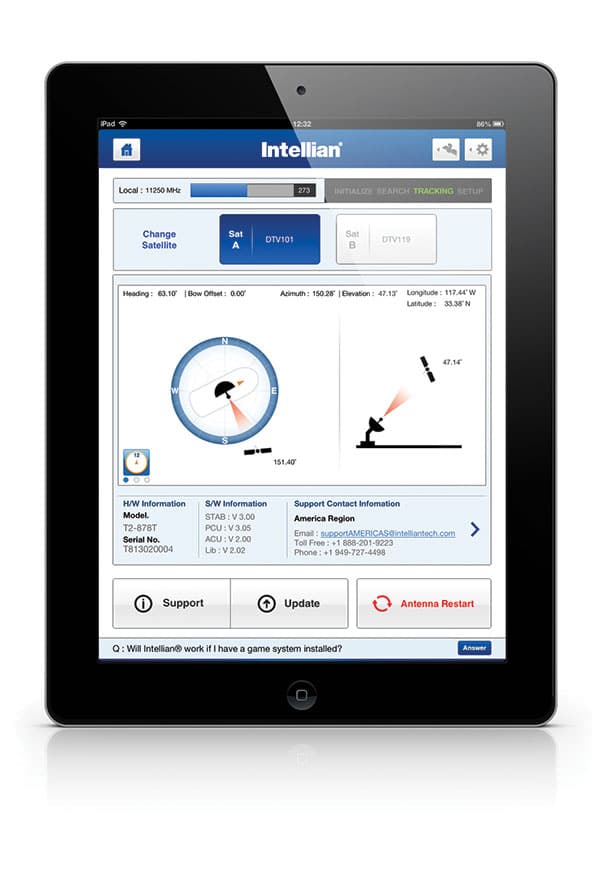


They say fishing amounts to hours of boredom interrupted by split seconds of excessive excitement. But to relieve some of the monotony, new satellite antennas can bring in high-definition satellite TV while offshore of North and South America, and changing zones is easy with an iPhone app.
“Onboard TV is easy for boats plying U.S. and Bahamian coastal waters, but as sport-fishers venture farther south, signals wear thin and coverage fades,” says Paul Comyns of Intellian. “Our new s80HD satellite antenna not only has the capability to switch between three popular TV satellite carriers from North to South America, it can do it without changing equipment or hiring a tech to manually change the receiver settings and connections or [low noise block] modules.”
HDTV is mandatory today since owners have stripped out the old tube TVs for the space- and weight-saving elegance of new flat-panel TVs. You can still watch standard-definition TV, but it looks far worse on HDTVs than it ever did on the old sets. New satellite TV antennas are designed to capture Ka or Ku band HDTV broadcast signals. The K band is a shortwave band used primarily for radar and tracking devices. Ka band, used by some satellite broadcasters, is a K-band frequency above the K band. Ku, which is used by most satellite companies, is just under the K band — thus Ku.
In the past, when cruising from U.S. waters or even the outer Bahamas, DirecTV faded. The polarity and frequency of the available signals changed too. The satellite antenna had to adjust to snag a picture. Say you’re going to Mexican or Central American waters — you’ll lose DirecTV as you’re crossing the Gulf and have to capture Sky Mexico. As you leave Central America and approach South America, your antenna must be able to capture yet another provider.
Switching polarity and frequency used to be a complex undertaking. It required a new LNB module. The LNB converts a fairly complex satellite signal into a signal capable of being pushed through a simple coaxial cable. In most satellite receivers, the LNB is the device on a boom suspended in front of the dish. Changing from one band to another required a hardware change by a tech who could reach the antenna and change the hardware and reprogram it. No more. Both Intellian and KVH Industries offer LNBs that span several popular satellite providers with one piece of hardware.
“Our s80HD WorldView system uses one single piece of hardware to receive three different satellite TV providers,” Comyns says. “To redirect from DirecTV to Mexico Air, our app-controlled systems let the user change the antenna from anywhere on board to capture the signal.” There are more advantages to the Intellian system too. One of the best is that the system requires no input from a gyrocompass to get a fix and maintain it. That means it’s always available. Wi-Fi capabilities are enhanced, and Bluetooth connectivity establishes PC connections too.
At sea, you’ll be rocking and rolling, and your antenna must be able to dance along with it. Inside Intellian’s s80HD 26.1-by-27.4-inch dome, the 32-inch dish can spin 360 degrees and can manage 25 degrees of roll in either direction plus 15 degrees and 8 degrees of pitch and yaw, respectively, at a six-second wave period. If you can keep your popcorn down in that, you can stay with the movie. You can pipe unique programming from any of three satellites to as many as 16 TVs or a combination of TVs and digital video recorders simultaneously. DVRs require two lines that could be used for TVs.
The compact system is ideal for sport-fishers in the 50- to 60-foot class and, in the United States, costs $24,995, not including a satellite TV subscription. It’s Dish- or DirecTV-capable in the U.S., and Sky Mexico-, DirecTV Latin America- or Sky Brasil-capable in South America.
KVH’s TracVision HD7 system also tracks three DirecTV satellites and feeds up to eight TVs or four DVRs — or any combination using the eight channels. It’s more compact at 26 by 27 inches, making it a good choice for smaller vessels, too. Each satellite system — DirecTV, Sky Mexico or Latin American — can be accessed by the Tri-Americas HD7 ($14,490) and can be programmed for the available satellite signal with an iOS app. The antenna sports comparable roll, pitch and yaw capabilities also measured at a six-second wave period.
With HDTV so easy to have, high seas fishing can coexist with arena sports.







